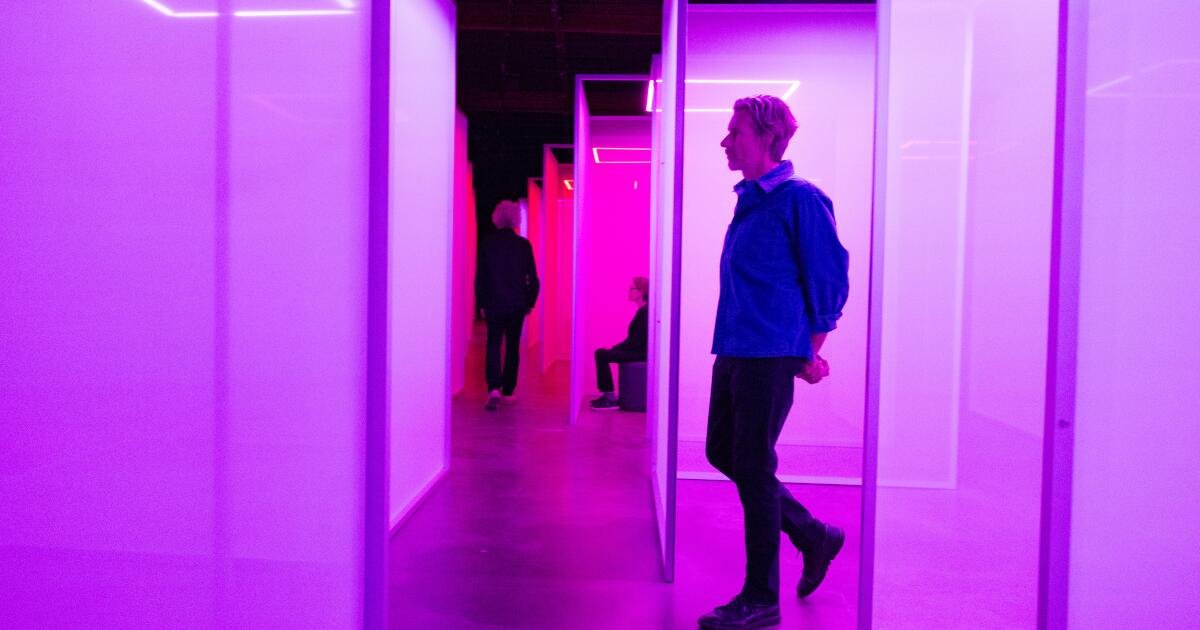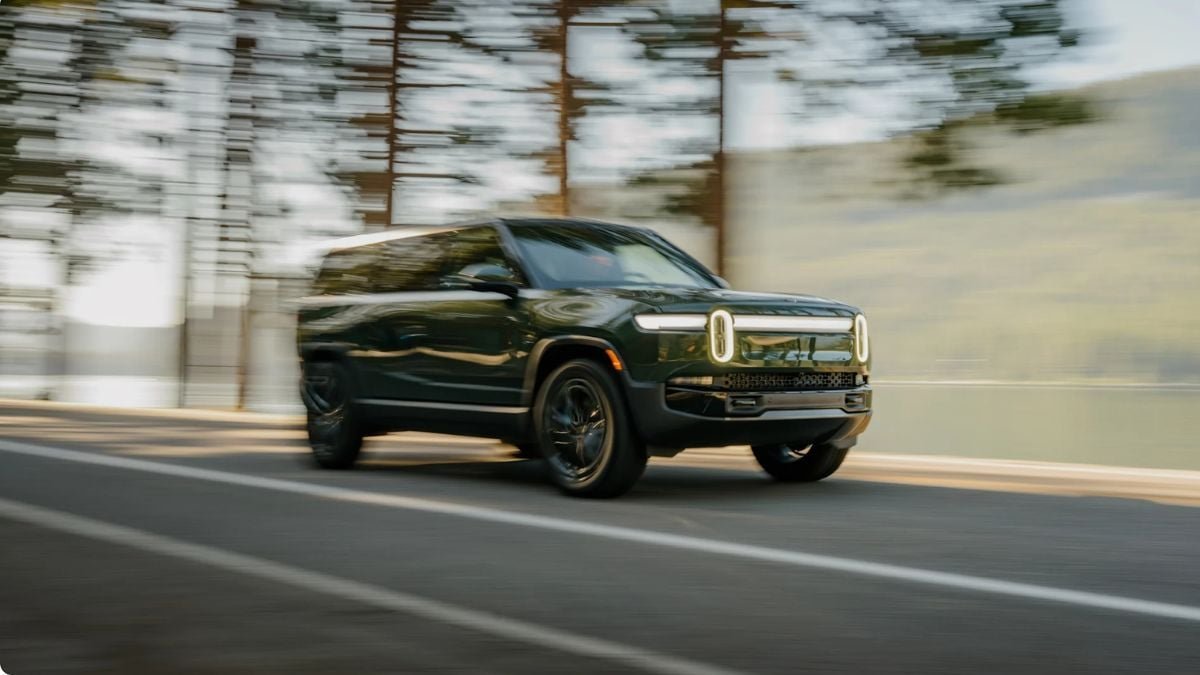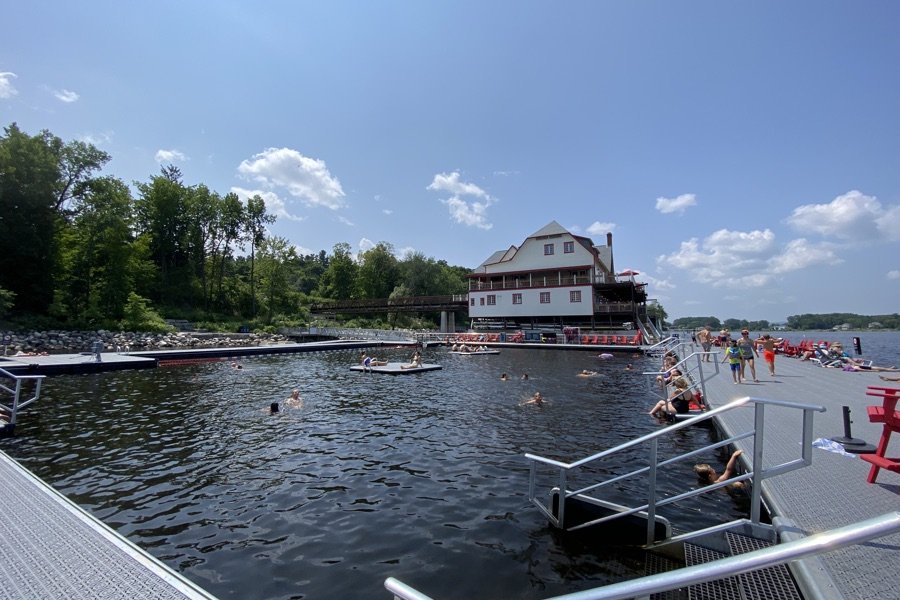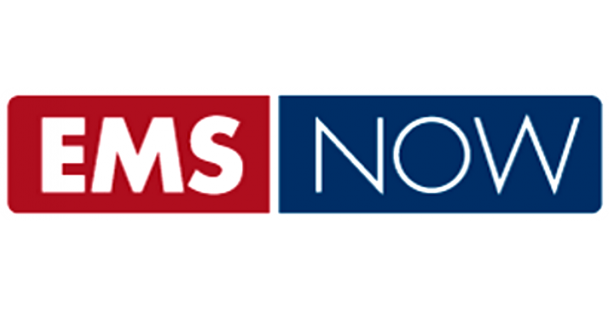Travel Journals
Take a shortcut to ‘womb-like’ euphoria at L.A.’s Chromasonic Field

The world inside a downtown L.A. warehouse seemed to come to a halt, and all I saw was a blur of colors, where pinkish-red hues bled into shades of yellow and purple. And I was surprised at what I felt: rested but not tired. This was a deep, calming state, one in which I was wide awake but unable to zero in on a specific thought or concern.
Even if only for a moment, worries, loneliness and to-do lists felt as if they were sailing by. Everything I have a tendency to dwell on was present but also slightly out of reach. Although I visited a Chromasonic installation in December, with 2025 off to a stressful start — our region struck by devastating wildfires that have displaced tens of thousands — I’ve been eager to return.
Descriptions for immersive experiences in 2025 have the tendency to sound like mental health retreats. Many boast an ability to surround participants in awe, prompt restorative mindfulness, alleviate anxiety or inspire a dopamine release.
Chromasonic’s downtown Los Angeles exhibit aims to help guests reach a calming, introspective state.
(Chromasonic)
And so it was that I found myself lying on a concrete floor, a small pillow beneath my head and translucent upright slabs surrounding me — aluminum frames with a lightweight, sheer-screened fabric designed to diffuse light. I’ve set foot in many light-and-sound installations over the years and am used to being promised something akin to a world of wonder. If all goes well, I‘ll see some otherworldly art, maybe get a chance to play.
And yet, at Chromasonic, I didn’t want to leave — or move, really.
Chromasonic is a newly opened walk-through art installation in downtown. There’s also a Chromasonic space in Venice, which launched in 2021 and is a more intimate, solitary zone. In downtown’s Arts District, the exhibit — Chromasonic Field is its official name — you’re free to wander and may intermingle with other groups, albeit extremely quietly.
I stroll in and out of mini, boxy spaces while slowly shifting ceiling LED lights make their boundaries feel slightly elusive. A soundtrack of Brian Eno-inspired ambience graces the room, audio in which the synthetic and human intermingle until it’s impossible to discern an instrument. The entire area is dedicated to the transitory.
“What is interesting about Chromasonic is that there’s no cultural context to the sound and no cultural context to the light,” says Susan Magsamen, co-author of “Your Brain on Art: How the Arts Transform Us.” Magsamen is also a faculty member in the department of neurology at Johns Hopkins University, where her academic focus is, in part, on the intersection of the arts and mental health.
“You’re dislocated,” Magsamen says of a Chromasonic work. “It’s not dissonant, but it’s detached. You’re in an suspended space that is very womb-like. There’s nothing to hold on to, to make a pattern about. It’s not designed with a pattern, but it changes. So one of the things it does is it allows your brain to actually rest because there’s nothing to figure out.”
Chromasonic’s creators: Harriet Girardoni, standing from left, and Orpheo McCord; Johannes Girardoni, sitting from left, and Joel Shearer. The space aims to allow us to hear light and see sound.
(Jason Armond / Los Angeles Times)
Chromasonic is the creation of four artists. Its thesis falls somewhere between art and science. When asked about its emotional ambition, Johannes Girardoni, 57, co-founding artist and Chromasonic’s head of art, speaks of the sort of transcendent experiences most associate with, say, nature, or carefully designed communal environments — an art museum, perhaps, or, for some, a theme park.
A Chromasonic environment, says Girardoni, is designed to be something of a fast track to a meditative state.
“It’s almost like a hack,” Girardoni says. “Your brain and your senses are being activated in very different ways because you’re not finding information — you’re not finding normal narrative and normal reality. Removing all that information — normal physical reality — allows us to move into this expanded, new way of sensing awareness. I would say it’s a very efficient way to get into feeling connected to this moment. It’s a very inward and reflective experience.”
Art-wise, there are antecedents. A collaboration with fellow installation artist and partner Harriet Girardoni, as well as with sound artists/composers Orpheo McCord and Joel Shearer, Chromasonic at first blush appears indebted to the work of Los Angeles-born artist James Turrell in that it is using light as one of its primary materials. The Venice-based Johannes doesn’t shy away from that connection, paraphrasing a Turrell quote about art enabling us to “sense yourself sensing.”
“What we’re doing, specifically, with Chromasonic,” Johannes says, “is understanding that we can increase mindfulness and mental health — just as a stress reduction. It’s art in service of well-being. That’s the main drive of our work.”
Chromasonic is an immersive art show in Los Angeles.
(Jason Armond / Los Angeles Times)
In terms of accomplishing that goal, the Chromasonic team has been working on ways to turn light into sound and vice versa. Johannes speaks of the downtown space eventually hosting live music performances, the lighting in the venue responding in real time to the musicians. They call this process “Chromasonic Refrequencing,” and it’s an attempt to synchronize light and sound waves, using technology to visualize these frequencies.
Conceptually, it’s a belief that we can see sound and hear light. The software, says Johannes, allows the team to witness how light and sound waves expand and contract. Interpreting them can be a more impressionistic practice, but if it all works, says Johannes, a Chromasonic space will feel as if it’s “living and breathing.”
“Red,” says Johannes, “is a long wave, and violets are a short wave. You can map that to sound. A long wave will generate low sound, if you’re mapping that in real time. … When we compose, we have to be careful. If you’re generating too many different sounds, you’ll get white light very quickly. White light is all frequencies. This is very much about reducing stimulus.”
Researcher Magsamen thinks the Chromasonic team is on to something.
“I think this idea of being radically present marries the other side of the coin to anxiety, depression and fatigue,” Magsamen says. “They’re trying to understand what is noise and what is signal.”
Chromasonic Field can feel like a blur of light and sound, a liminal space aimed at relaxation.
(Chromasonic)
Once, when feeling especially down, someone close to me prescribed rest. “Rest would be good,” she emphasized, and sure, I went to bed. But I tossed, turned and generally did anything but rest. I thought of her advice while lying at Chromasonic, for I think this is the kind of rest she meant, one where concentration and focus were free of the unease they’re often tethered to.
For here, everything was slightly abstracted — a sonic hum gave way to a hazy mixture of lights as I glanced at various ideas and impressions. I’ve felt peace like this before — a trip to Sequoia National Park comes to mind — but what I liked about Chromasonic was that any sense of place felt distorted.
I knew, of course, I was downtown. And yet in this liminal space dedicated to emotional drifting, I truly felt like I was nowhere at all.
Travel Journals
I Bought a $250 Adapter Because Rivian Said I Could Charge at Tesla Stations, but After Two Road Trips and Multiple Failures, I Feel Like I Was Misled

This evening, I was scrolling through the “RIVIAN Electric Vehicles Discussion” group on Facebook and came across a post that immediately grabbed my attention. As EV adoption grows, one of the biggest questions many Rivian owners face isn’t about performance or range; it’s about charging. And when you’re on the road with only 30 miles of range left, the difference between clear communication and misleading assumptions could mean the difference between a smooth trip and a total panic.
Marc, a Rivian R1S owner, shared a frustrating story that I think many EV drivers, especially new ones, can relate to. It wasn’t about the truck itself, but rather about the charging ecosystem Rivian said he’d be able to use.
Here’s exactly what Marc wrote:
“When I purchased my R1S, I was told that I could charge at Tesla chargers, so I bought the adapter from Rivian for $250. I went to my first Tesla chargers on I-95 in Connecticut and found out that I can only charge at the Tesla Superchargers. I’m on another road trip this weekend and went to the Tesla Supercharger in Lee, Massachusetts. Of course, that didn’t work, and when I called Rivian roadside support with only 30 miles of range left, I was told that only certain Tesla Superchargers are available to Rivians. I then found an Electrify America Supercharger, and that didn’t work either. I finally found a Mercedes Supercharger, and fortunately, that worked great. Long story short, I’m pretty upset that Rivian’s sales claim that I can charge at Tesla chargers was not accurate.”
Let’s pause there.
If you’ve never driven an EV before, you might assume, understandably, that a Tesla charging adapter means you can plug into any Tesla charger and be on your way. But as Marc discovered the hard way, that’s just not how it works. And even some EV veterans have found themselves tripped up by how inconsistent or poorly explained this compatibility can be.
Not All Tesla Superchargers Are Created Equal
While it’s technically true that Rivian’s can charge at some Tesla Supercharger stations, only select sites are currently open to non-Tesla vehicles. These locations are visible within the Tesla app, which shows “Magic Dock” compatibility or NACS support based on your vehicle. But here’s the catch: unless someone explicitly tells you to check the Tesla app and shows you how to filter for compatible stations, you might assume that the $250 adapter unlocks all Superchargers. And that’s where owners like Marc are feeling misled.
It’s a complaint we’re seeing more and more, where owners feel that the promise of convenient charging turned into a scavenger hunt with no guarantee of success. And when you add in situations like this Rivian owner whose R1S took over an hour to charge at a Level 3 station and still needed service, it’s easy to see why trust in EV charging infrastructure is a work in progress.
Charging Support, Or Charging Confusion?
Marc’s experience didn’t just stop at Tesla. When Electrify America also failed him, he was left scrambling to find alternatives. Thankfully, a Mercedes-branded charging station saved the day, but it shouldn’t take multiple failed attempts to get a full battery.
This reminds me of another recent story we covered, where a Rivian owner had their vehicle plugged in overnight and woke up to a dead battery, leading to confusion and concern about whether their system was functioning properly at all.
Community to the Rescue
While Marc’s frustration is absolutely justified, the Rivian community didn’t leave him hanging. Several other owners chimed in under his post to offer advice and perspective, and their comments help illustrate the broader picture that new owners need to hear.
Ken responded: “You can charge at Tesla Destination Chargers, but you need a different adapter than the Tesla Supercharger adapter. As for the Superchargers, only use the Tesla app to see which ones are available.”
That distinction between Destination Chargers (usually slower, AC-based chargers at hotels and businesses) and Tesla Superchargers (fast DC stations for long-distance travel) is critical. And unfortunately, it’s one that’s often glossed over in casual sales conversations.
Vincent added: “Get the Tesla app, which will tell you which Tesla Superchargers are compatible with the adapter. My Rivian delivery team was clear on this, and the Rivian message app is also a good resource. Have Fun.”
That’s helpful, if you know to ask. And if you don’t, you could easily end up in a situation like Marc’s.
Lastly, Jann shared a much smoother experience: “Drove to California and back from Florida, 6,000 total miles. The Rivian trip planner took me exactly where I needed to charge. Piece of cake.”
Jann’s story shows that long-distance road trips in a Rivian can absolutely go off without a hitch, but only if you use the right tools and have the right expectations.
Why the Misunderstanding Happens
Rivian, like many EV startups, is navigating a rapidly changing infrastructure landscape. Tesla’s charging network is the gold standard in the U.S., and with the rollout of the NACS (North American Charging Standard), more and more non-Tesla EVs will have access to that network. But it’s not universal yet, and owners need to know that upfront.
Rivian does offer guidance through their delivery advisors and message app, but not everyone gets the same level of support. Some customers get a walkthrough of the Tesla app and are told exactly how to identify compatible Superchargers. Others, like Marc, are simply told, “You can charge at Tesla stations”, and left to figure it out themselves.
That gap in communication is what turns excitement into disappointment.
And when you combine that with issues like a Rivian owner who charged for 11 hours and only got 70 miles or others paying to support Tesla while secretly resenting it, it becomes clear that frustration around charging is as much about expectations as it is about execution.
Journalist Insight: Why This Matters
As an automotive journalist watching this unfold, I think there’s a bigger takeaway here beyond just one person’s road trip mishap. We’re witnessing the early growing pains of a charging transition that will define how EVs are adopted by the masses.
Marc did everything right. He bought the adapter. He followed the promise. He was proactive. But the information pipeline failed him.
And when even Electrify America, the supposed fallback, doesn’t deliver, it’s no wonder owners are left wondering if they made the right call. Some are even stuck charging for hours with no improvement in range, or waking up to a drained battery and no clear answer.
A Moral for All EV Owners
So here’s the moral: if you’re going to drive an EV, especially one from a startup brand, you need to become your own advocate. Learn the charging landscape, get the apps, read the forums, and double-check everything the salesperson tells you. Because the difference between a seamless journey and a weekend ruined by failed chargers might come down to something as small as clicking the right icon in an app.
And if you’re on the other side, working in EV sales or delivery, this is your reminder that what you say (or don’t say) matters. Clarity builds confidence. Confusion builds resentment.
Your Turn
Have you ever had a charging experience that went south because of poor information? Do you think EV brands are doing enough to prepare buyers for real-world charging?
Let me know in the comments, I’d love to hear what worked for you, what didn’t, and how we can all help new owners avoid feeling like Marc did.
Narek Hareyan is a young automotive journalist with experience in a golf cart dealership and an interest in the automotive industry. Follow Narek on X for daily news coverage about cars.
Travel Journals
Road trip toys for 2 year olds cheap – emsnow.com
Travel Journals
Heads Up: New Ottawa airport bus, Munster farm dinner, river swimming, Quebec spas

484
This week’s Heads Up has the scoop on rental sports gear in the Outaouais, a farm-to-table dinner in Munster, a new bus to the Ottawa airport, a new restaurant in Kemptville, a bike ride near Eganville, açaí treats at St. Laurent Shopping Centre, day tripping to New Edinburgh and Rockcliffe, and more. Enjoy!
Cheese shop getting close to 100 percent Canadian stock
As you already know, I’m a big fan of supporting Canadian products—just check out my big guide to shopping locally. So a recent Facebook post by the Balderson Village Cheese Store, just outside Perth, caught my eye. The store’s owners have been making a concerted effort to stock 100 percent made-in-Canada foods. They’re about 75 percent of the way there and hope to have 100 percent Canadian stock by the end of the year. Well done!
You can rent scooters, pontoon boats and more in the Outaouais
Want to explore the great outdoors in the Outaouais, but you don’t have the gear? Tourisme Outaouais has this handy list of companies that rent out kayaks, paddleboards, canoes, electric bikes, scooters, pontoon boats and more.
OC Transpo to launch new bus to the airport
Perhaps finally realizing that folks travelling from Ottawa’s east end to Ottawa International Airport don’t much fancy taking three trains to reach their destination, OC Transpo is launching a direct bus service connecting the St. Laurent, Train and Hurdman stations to the airport. According to this CTV Ottawa story, Route 105 will launch on Sunday, August 24, and will run every half hour, 24 hours a day, seven days a week. The bus is anticipated to take 33 minutes to travel from St. Laurent to the airport.
Quebec loves its Nordic spas
Quebec seems to have embraced the Nordic spa concept—the circuit of hot tub or sauna, cold pool or shower, relaxation and repeat—more strongly than just about anywhere else in Canada. I’ve written a post about some of my favourite Quebec Nordic spas, and it barely scratches the surface. My friend Hilary Nangle recently wrote a post about her favourite Quebec Nordic spas and while there’s a bit of overlap between the two pieces, she’s discovered quite a few spots that I haven’t made it to … yet.
Science fiction, fantasy and horror book convention is coming to Kanata
I wanted to mention this event on the website last year, but by the time I heard about it, it had sold out! So if you’re a fan of Canadian science fiction, fantasy and horror novels, you might want to get your ticket to Can*Con now. You can meet authors, buy books, take classes, pitch your own book to agents and more. It’s happening at the Brookstreet Hotel in Kanata from October 17 to 19.
New restaurant opens in Kemptville
Named for a famous local Holstein bull, Goldwyn’s restaurant opened this past weekend at 25 Clothier Street East in downtown Kemptville. It promises diners “a modern take on the Wild West at our elevated country western saloon.” Sounds like fun!
You can take a staycation in New Edinburgh and Rockcliffe
Fancy staying close to home? I have just the suggestion: a day spent exploring New Edinburgh, Lindenlea and Rockcliffe. From the new(ish) NCC River House on the Ottawa River to a posh grocery store and a great place to pick up consignment designer clothes, you can read my day trip tips in the Ottawa Business Journal.
Saunders Farm Pig and Corn Roast tickets are available
Most years, the farm-to-table Pig and Corn Roast at Saunders Farm in Munster sells out. So if you want to go to this year’s event on Sunday, August 24, you might want to get your tickets now.
Scenic August bike ride will take cyclists along Eganville backroads
If you want to challenge yourself to a self-supported, non-racing bike ride through the hills and along the backroads near Eganville, now’s the time to register for this year’s Tour de Bonnechere on Sunday, August 24. You can choose from 50km, 65km and 100km routes, as well as a 20km family ride.
You can try a superfood at St. Laurent Shopping Centre
Perhaps açaí berries are old hat to you. I’d heard of them but hadn’t had a chance to taste the Brazilian “superfood” until I was invited to try it at Rio Açaí at St. Laurent Shopping Centre. (The owners also have a location at 35 allée de Hambourg in Gatineau.)
Açaí berries have become trendy in recent years for their health benefits. At Rio Açaí, you can try them in a bowl with your choice of other fruits (I picked mangoes, strawberries and blueberries). The consistency of puréed açaí is a bit like tapioca pudding and it isn’t super sweet, so it made a nice combo with the sweet, dense fruit. You can also try other Brazilian specialties at the takeout spot, such as warm cheese bread (it’s really good) and, of course, coffee.
(Disclosure: I received free products for review purposes. The shop did not review or approve this post. All opinions are my own.)
Looking for more tips on things to see and do in and around Ottawa? Subscribe to my free weekly newsletter or order a copy of my book, Ottawa Road Trips: Your 100-km Getaway Guide.
As the owner of Ottawa Road Trips, I acknowledge that I live on, work in and travel through the unceded, unsurrendered territory of the Algonquin Anishinaabeg Nation. I am grateful to have the opportunity to be present on this land. Ottawa Road Trips supports Water First, a non-profit organization that helps address water challenges in Indigenous communities in Canada through education, training and meaningful collaboration.
-

 Brand Stories2 weeks ago
Brand Stories2 weeks agoBloom Hotels: A Modern Vision of Hospitality Redefining Travel
-

 Brand Stories1 week ago
Brand Stories1 week agoCheQin.ai sets a new standard for hotel booking with its AI capabilities: empowering travellers to bargain, choose the best, and book with clarity.
-

 Destinations & Things To Do2 weeks ago
Destinations & Things To Do2 weeks agoUntouched Destinations: Stunning Hidden Gems You Must Visit
-

 Destinations & Things To Do1 week ago
Destinations & Things To Do1 week agoThis Hidden Beach in India Glows at Night-But Only in One Secret Season
-

 AI in Travel2 weeks ago
AI in Travel2 weeks agoAI Travel Revolution: Must-Have Guide to the Best Experience
-

 Brand Stories1 month ago
Brand Stories1 month agoVoice AI Startup ElevenLabs Plans to Add Hubs Around the World
-

 Brand Stories3 weeks ago
Brand Stories3 weeks agoHow Elon Musk’s rogue Grok chatbot became a cautionary AI tale
-

 Asia Travel Pulse1 month ago
Asia Travel Pulse1 month agoLooking For Adventure In Asia? Here Are 7 Epic Destinations You Need To Experience At Least Once – Zee News
-

 AI in Travel1 month ago
AI in Travel1 month ago‘Will AI take my job?’ A trip to a Beijing fortune-telling bar to see what lies ahead | China
-

 Brand Stories2 weeks ago
Brand Stories2 weeks agoContactless Hospitality: Why Remote Management Technology Is Key to Seamless Guest Experiences

